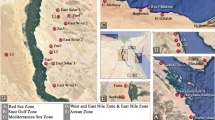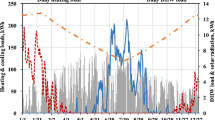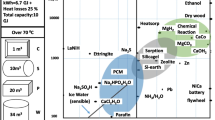Abstract
The thermal comfort level of Chinese residents in the hot-summer and cold-winter zone is increasing with economic development in recent years. More district heating and cooling systems were installed in these areas. Supported by the government, ground source heat pump (GSHP) is used as a common environmentally friendly district heating and cooling system in many residential communities. However, the evaluation of the real performance of GSHP is limited, especially limited understanding of the common issue of thermal imbalance of GSHP systems over several years—the mismatch between heat extraction from and rejection to the ground. Performance of GSHP systems can deteriorate over years if the thermal imbalance is significant and not addressed. For GSHP in the hot-summer and cold-winter climate zone, there are few thermal imbalance studies based on real field data and modeling. To address this gap, this paper proposes an integrated simulation model to evaluate thermal imbalance of GSHP systems considering key influencing factors including occupant behavior and heat pump performance. A case study was conducted to simulate and analyze the actual operation of GSHP in Chinese residential buildings. The indoor comfort temperature setting and flexibility of residents’ control on indoor terminal air-conditioning units determine the actual heating and cooling demand in residential buildings, which resulted in differences in thermal imbalance for GSHP systems. It was found that GSHP systems with radiant floor only for heating lead to the most severe thermal imbalance, while GSHP systems with fan coil units or radiant ceiling for cooling and/or heating achieved much better thermal balance. The proposed thermal imbalance ratio is an important indicator that can be used to evaluate thermal imbalance of GSHP systems and thus inform their design and operation for energy efficiency.
Similar content being viewed by others
Abbreviations
- GSHP:
-
ground source heat pump
- HSCW:
-
hot-summer cold-winter climate zone
- AC:
-
air-conditioning
- FCU:
-
fan coil uni
- DeST:
-
Designer’s Simulation Toolkits
- COP:
-
coefficient of performance
- IR:
-
imbalance ratio
References
An J, Yan D, Hong T, Sun K (2017). A novel stochastic modeling method to simulate cooling loads in residential districts. Applied Energy, 206: 134–149.
An J, Yan D, Hong T (2018). Clustering and statistical analyses of air-conditioning intensity and use patterns in residential buildings. Energy and Buildings, 174: 214–227.
Building Energy Research Center of Tsinghua University (2017). China Buidling Energy Use 2017. Beijing: China Architecture and Building Press.
Chiasson AD, Spitler JD, Rees SJ, Smith MD (2000). A model for simulating the performance of a shallow pond as a supplemental heat rejecter with closed-loop ground-source heat pump systems ASHRAE Transactions, 106(2):107–121.
Chiasson AD, Yavuzturk C (2003). Assessment of the viability of hybrid geothermal heat pump systems with solar thermal collectors. ASHRAE Transactions, 109(2): 487–500.
Costanzo V, Yao R, Li X, Liu M, Li B (2019). A multi-layer approach for estimating the energy use intensity on an urban scale. Cities, 95: 102467.
Cui W, Zhou S, Liu X (2015). Optimization of design and operation parameters for hybrid ground-source heat pump assisted with cooling tower. Energy and Buildings, 99: 253–262.
Dong B, Yan D, Li Z, Jin Y, Feng X, Fontenot H (2018). Modeling occupancy and behavior for better building design and operation—A critical review. Building Simulation, 11: 899–921.
Garber D, Choudhary R, Soga K (2013). Risk based lifetime costs assessment of a ground source heat pump (GSHP) system design: Methodology and case study. Building and Environment, 60: 66–80.
Guo S, Yan D, Peng C, Cui Y, Zhou X, Hu S (2015). Investigation and analyses of residential heating in the HSCW climate zone of China: Status quo and key features. Building and Environment, 94: 532–542.
Guo M, Diao N, Man Y, Fang Z (2016). Research and development of the hybrid ground-coupled heat pump technology in China. Renewable Energy, 87: 1033–1044.
Hong T, Jiang Y (1997). A new multizone model for the simulation of building thermal performance. Building and Environment, 32: 123–128.
Hong T, Yan D, D’ Oca S, Chen CF (2017). Ten questions concerning occupant behavior in buildings: The big picture. Building and Environment, 114: 518–530.
Hu S, Yan D, Cui Y, Guo S (2016). Urban residential heating in hot summer and cold winter zones of China—Status, modeling, and scenarios to 2030. Energy Policy, 92: 158–170.
Jin Z, Eikevik TM, Neksa P, Hafner A (2016). Investigation on CO2 hybrid ground-coupled heat pumping system under warm climate. International Journal of Refrigeration, 62: 145–152.
Jin Z, Eikevik TM, Neksa P, Hafner A (2017). A steady and quasisteady state analysis on the CO2 hybrid ground-coupled heat pumping system. International Journal of Refrigeration, 76: 29–41.
Kindaichi S, Nishina D (2018). Simple index for onsite operation management of ground source heat pump systems in coolingdominant regions. Renewable Energy, 127: 182–194.
Kjellsson E, Hellstrom G, Perers B (2010). Optimization of systems with the combination of ground-source heat pump and solar collectors in dwellings. Energy, 35: 2667–2673.
Li S, Yang W, Zhang X (2009). Soil temperature distribution around a U-tube heat exchanger in a multi-function ground source heat pump system. Applied Thermal Engineering, 29: 3679–3686.
Li W, Lin X, Cao C, Gong Z, Gao Y (2018). Organic Rankine Cycleassisted ground source heat pump combisystem for space heating in cold regions. Energy Conversion and Management, 165: 195–205.
Liu X, Lu S, Hughes P, Cai Z (2015). A comparative study of the status of GSHP applications in the United States and China. Renewable and Sustainable Energy Reviews, 48: 558–570.
Liu Z, Xu W, Zhai X, Qian C, Chen X (2017). Feasibility and performance study of the hybrid ground-source heat pump system for one office building in Chinese heating dominated areas. Renewable Energy, 101: 1131–1140.
MOHURD (2010). JGJ 134-2010. Design Standard for Energy Efficiency of Residential Buildings in Hot Summer and Cold Winter Zone. Ministry of Housing and Urban-Rural Development of China. (in Chinese)
MOHURD (2012). GB50736-2012. Code for design of heating ventilation and air conditioning. Ministry of Housing and Urban-Rural Development of China. (in Chinese)
Perers B (2006). A dynamic collector model for simulation of the operation below the dewpoint in heat pump systems. Paper presented at the Euro Sun, Glasgow, UK.
Pertzborn A, Hackel S, Nellis G, Klein S (2011). Experimental validation of a ground heat exchanger model in a hybrid ground source heat pump. HVAC&R Research, 17: 1101–1114.
Qian H, Wang Y (2014). Modeling the interactions between the performance of ground source heat pumps and soil temperature variations. Energy for Sustainable Development, 23: 115–121.
Qian M, Yan D, An J (2019). Field test and modeling analysis on unbalance of heat extraction and rejection of GSHP systems with different AC terminal units. IOP Conference Series: Earth and Environmental Science, 238: 012041.
Qu S, Han J, Sun Z, Yin R, Ji R, Chai C (2019). Study of operational strategies for a hybrid solar-geothermal heat pump system. Building Simulation, 12: 697–710.
Ren X, Yan D, Wang C (2014). Air-conditioning usage conditional probability model for residential buildings. Building and Environment, 81: 172–182.
Sarbu I, Sebarchievici C (2014). General review of ground-source heat pump systems for heating and cooling of buildings. Energy and Buildings, 70: 441–454.
Southard L, Liu X, Spitler J (2014). Performance of HVAC systems at ASHRAE HQ: Part one. ASHRAE Journal, 56(9): 14–22.
Spitler JD, Southard L, Liu X (2017). Ground-source and air-source heat pump system performance at the ASHRAE headquarters building. Paper presented at the 12th IEA Heat Pump Conference, Rotterdam, the Netherlands.
Spitler JD, Gehlin S (2019). Measured performance of a mixed-use commercial-building ground source heat pump system in Sweden Energies, 12: 2020.
Wang C, Yan D, Sun H, Jiang Y (2016). A generalized probabilistic formula relating occupant behavior to environmental conditions. Building and Environment, 95: 53–62.
Wang Y, Liu Z, Yuan X, Niu X, Liu J (2019). Investigation of the influence of groundwater seepage on the heat transfer characteristics of a ground source heat pump system with a 9-well group. Building Simulation, 12: 857–868.
Wu W, Wang B, You T, Shi W, Li X (2013). A potential solution for thermal imbalance of ground source heat pump systems in cold regions: Ground source absorption heat pump. Renewable Energy, 59: 39–48.
Wu W, You T, Wang B, Shi W, Li X (2014a). Evaluation of ground source absorption heat pumps combined with borehole free cooling. Energy Conversion and Management, 79: 334–343.
Wu W, You T, Wang B, Shi W, Li X (2014b). Simulation of a combined heating, cooling and domestic hot water system based on ground source absorption heat pump. Applied Energy, 126: 113–122.
Wu W, Skye HM (2018). Progress in ground-source heat pumps using natural refrigerants. International Journal of Refrigeration, 92: 70–85.
Xi J, Li Y, Liu M, Wang RZ (2017). Study on the thermal effect of the ground heat exchanger of GSHP in the Eastern China area. Energy, 141: 56–65.
Xing L, Cullin JR, Spitler JD (2012). Modeling of foundation heat exchangers—Comparison of numerical and analytical approaches. Building Simulation, 5: 267–279.
Yan D, Xia J, Tang W, Song F, Zhang X, Jiang Y (2008). DeST — An integrated building simulation toolkit Part I: Fundamentals. Building Simulation, 1: 95–110.
Yang J, Xu L, Hu P, Zhu N, Chen X (2014). Study on intermittent operation strategies of a hybrid ground-source heat pump system with double-cooling towers for hotel buildings. Energy and Buildings, 76: 506–512.
Yan D, O’ Brien W, Hong T, Feng X, Burak Gunay H, Tahmasebi F, Mahdavi A (2015). Occupant behavior modeling for building performance simulation: Current state and future challenges. Energy and Buildings, 107: 264–278.
Yan D, Hong T, Dong B, Mahdavi A, D’ Oca S, Gaetani I, Feng X (2017). IEA EBC Annex 66: Definition and simulation of occupant behavior in buildings. Energy and Buildings, 156: 258–270.
Yavuzturk C, Spitler JD (2000). Comparative study of operating and control strategies for hybrid ground-source heat pump systems using a short time step simulation model. ASHRAE Transactions, 106(2): 192–209.
You T, Wang B, Wu W, Shi W, Li X (2014). A new solution for underground thermal imbalance of ground-coupled heat pump systems in cold regions: Heat compensation unit with thermosyphon. Applied Thermal Engineering, 64: 283–292.
You T, Wang B, Wu W, Shi W, Li X (2015). Performance analysis of hybrid ground-coupled heat pump system with multi-functions. Energy Conversion and Management, 92: 47–59.
You T, Wu W, Shi W, Wang B, Li X (2016). An overview of the problems and solutions of soil thermal imbalance of ground-coupled heat pumps in cold regions. Applied Energy, 177: 515–536.
Yu X, Yan D, Sun K, Hong T, Zhu D (2016). Comparative study of the cooling energy performance of variable refrigerant flow systems and variable air volume systems in office buildings. Applied Energy, 183: 725–736.
Zarrella A, Pasquier P (2015). Effect of axial heat transfer and atmospheric conditions on the energy performance of GSHP systems: A simulation-based analysis. Applied Thermal Engineering, 78: 591–604.
Zhai XQ, Qu M, Yu X, Yang Y, Wang RZ (2011). A review for the applications and integrated approaches of ground-coupled heat pump systems. Renewable and Sustainable Energy Reviews, 15: 3133–3140.
Zhang S, Zhang L, Wei H, Jing J, Zhou X, Zhang X (2016). Field testing and performance analyses of ground source heat pump systems for residential applications in Hot Summer and Cold Winter area in China. Energy and Buildings, 133: 615–627.
Zhang S, Zhang L, Zhang X (2017). Performance evaluation of existed ground source heat pump systems in buildings using auxiliary energy efficiency index: Cases study in Jiangsu, China. Energy and Buildings, 147: 90–100.
Zhao Z, Shen R, Feng W, Zhang Y, Zhang Y (2018). Soil thermal balance analysis for a ground source heat pump system in a hot-summer and cold-winter region. Energies, 11: 1206.
Zhou X, Yan D, Feng X, Deng G, Jian Y, Jiang Y (2016). Influence of household air-conditioning use modes on the energy performance of residential district cooling systems. Building Simulation, 9: 429–441.
Acknowledgements
This study was supported by the National Key Research and Development Project (No. 2018YFC1509006) and the National Natural Science Foundation of China (No. 51778321): Research on the quantitative description and simulation methodology of occupant behavior in buildings.
Author information
Authors and Affiliations
Corresponding author
Additional information
This is a U.S. government work and not under copyright protection in the U.S.; foreign copyright protection may apply 2020
Rights and permissions
About this article
Cite this article
Qian, M., Yan, D., An, J. et al. Evaluation of thermal imbalance of ground source heat pump systems in residential buildings in China. Build. Simul. 13, 585–598 (2020). https://doi.org/10.1007/s12273-020-0606-5
Received:
Revised:
Accepted:
Published:
Issue Date:
DOI: https://doi.org/10.1007/s12273-020-0606-5




